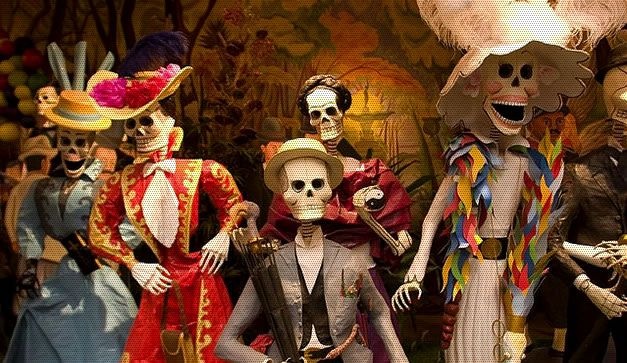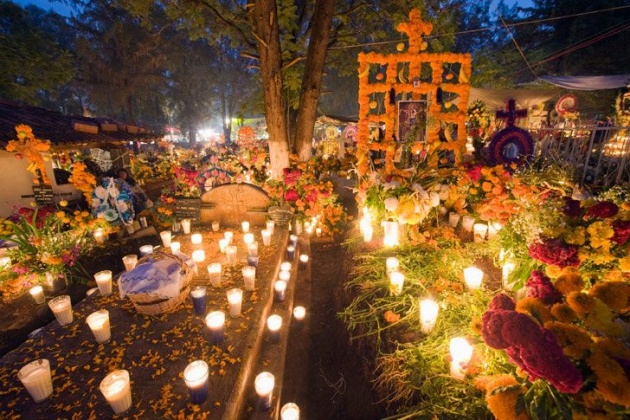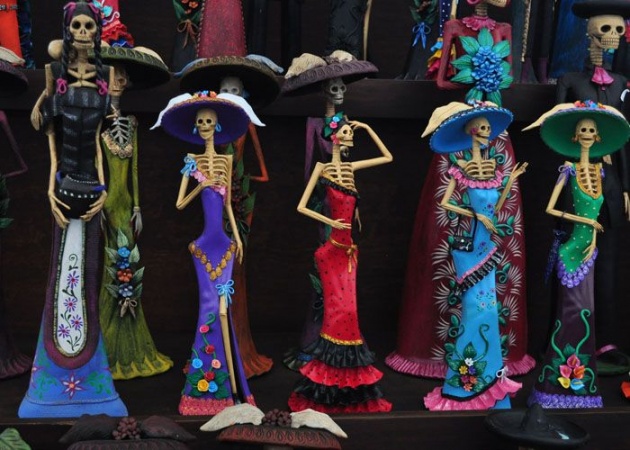Day of the Dead is a mexican holiday celebrated throughout Mexico, in particular the Central and South regions, and acknowledged around the world in other cultures. The holiday focuses on gatherings of family and friends to pray for and remember friends and family members who have died, and help support their spiritual journey. In 2008 the tradition was inscribed in the Representative List of the Intangible Cultural Heritage of Humanity by UNESCO

Though it may sound gloomy or morbid, it's not. It's a festive and colorful holiday. Mexicans visit cemeteries, decorate the graves and spend time there, in the presence of their deceased friends and family members. Prior to Spanish colonization in the 16th century, the celebration took place at the beginning of summer. It was moved to October 31, November 1 and November 2 to coincide with the Roman Catholic triduum festival of Allhallowtide: All Saints' Eve, All Saints' Day, and All Souls' Day. Traditions connected with the holiday include building private altars called ofrendas, honoring the deceased using sugar skulls, marigolds, and the favorite foods and beverages of the departed, and visiting graves with these as gifts. Visitors also leave possessions of the deceased at the graves.

Some families build altars or small shrines in their homes; these sometimes feature a Christian cross, statues or pictures of the Blessed Virgin Mary, pictures of deceased relatives and other persons, scores of candles, and an ofrenda. Traditionally, families spend some time around the altar, praying and telling anecdotes about the deceased. In some locations celebrants wear shells on their clothing, so when they dance, the noise will wake up the dead; some will also dress up as the deceased.
Public schools at all levels build altars with ofrendas, usually omitting the religious symbols. Government offices usually have at least a small altar, as this holiday is seen as important to the Mexican heritage.

Those with a distinctive talent for writing sometimes create short poems, called calaveras (skulls), mocking epitaphs of friends, describing interesting habits and attitudes or funny anecdotes. This custom originated in the 18th or 19th century, after a newspaper published a poem narrating a dream of a cemetery in the future, "and all of us were dead", proceeding to read the tombstones. Newspapers dedicate calaveras to public figures, with cartoons of skeletons in the style of the famous calaveras of José Guadalupe Posada, a Mexican illustrator. Theatrical presentations of Don Juan Tenorio by José Zorrilla (1817–1893) are also traditional on this day. Those with a distinctive talent for writing sometimes create short poems, called calaveras (skulls), mocking epitaphs of friends, describing interesting habits and attitudes or funny anecdotes. This custom originated in the 18th or 19th century, after a newspaper published a poem narrating a dream of a cemetery in the future, "and all of us were dead", proceeding to read the tombstones. Newspapers dedicate calaveras to public figures, with cartoons of skeletons in the style of the famous calaveras of José Guadalupe Posada, a Mexican illustrator. Theatrical presentations of Don Juan Tenorio by José Zorrilla (1817–1893) are also traditional on this day. José Guadalupe Posada created a famous print of a figure he called La Calavera Catrina ("The Elegant Skull") as a parody of a Mexican upper-class female. Posada's striking image of a costumed female with a skeleton face has become associated with the Day of the Dead, and Catrina figures often are a prominent part of modern Day of the Dead observances. 
A common symbol of the holiday is the skull (in Spanish calavera), which celebrants represent in masks, called calacas (colloquial term for skeleton), and foods such as sugar or chocolate skulls, which are inscribed with the name of the recipient on the forehead. Sugar skulls as gifts can be given to both the living and the dead. Other holiday foods include pan de muerto, a sweet egg bread made in various shapes from plain rounds to skulls and rabbits, often decorated with white frosting to look like twisted bones
.
This holiday is an excellent time to visit Mexico. Not only will you be able to witness these special celebrations, but you can also enjoy other advantages of Mexico in the Fall Season. Although families celebrate this holiday privately, there are many public displays that you can enjoy, Day of the Dead is celebrated in different ways in different locations throughout Mexico. Festivities tend to be more colorful in the southern region, particularly in the states of Michoacan, Oaxaca, and Chiapas.



